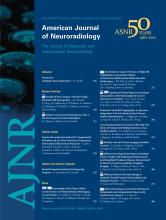Abstract
BACKGROUND AND PURPOSE: CCSVI has been proposed as a cause for MS. According to this theory, strictures of the IJV are among the described causes for CCSVI. Little is known about their influence on the hemodynamics of the CVBO. We used positional MR imaging to describe the influence of positional changes on the CVBO.
MATERIALS AND METHODS: Using the Fonar Upright MR imaging system, we performed venous time-of-flight angiography of the cervical region in the supine and sitting positions in 15 healthy volunteers. The image quality was rated; the positional findings and interindividual variances in the CVBO were analyzed.
RESULTS: A venous time-of-flight angiography of the cervical spine was feasible with good image quality. Strictures of 1 or both IJVs were found in 8 of 15 healthy volunteers in the supine position; however, none were visible in upright position. The IJV was not the main outflow route in the erect position. No relevant venous reflux was observed.
CONCLUSIONS: IJV strictures are a common finding in healthy volunteers in the supine position. They seem to be of no relevance in the erect position. This finding questions the validity of this criterion for the diagnosis of CCSVI. Reflux into the venous system was not visualized, and it remains to be seen whether it can be identified in patients with MS. Positional MR imaging enables operator-independent evaluation of the CVBO and may help to clarify the validity of the criteria for CCSVI.
ABBREVIATIONS:
- CCSVI
- chronic cerebrospinal venous insufficiency
- CVBO
- cerebral venous blood outflow
- EJV
- external jugular vein
- IJV
- internal jugular vein
- MIP
- maximum intensity projection
- NV
- nuchal veins
- VP
- veins of the vertebral plexus
- © 2012 by American Journal of Neuroradiology












